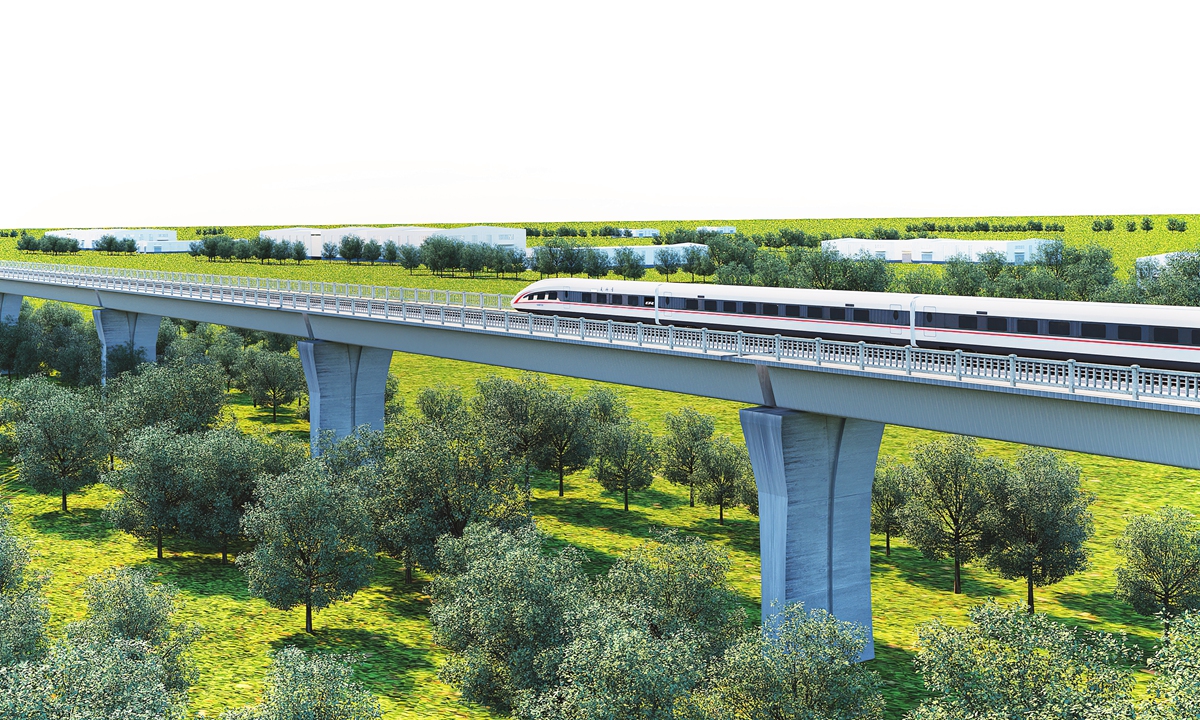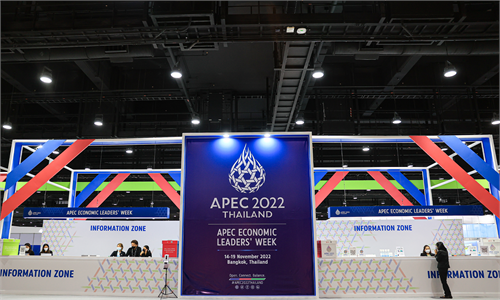China-Thailand railway to provide new momentum for regional economy and trade
Construction underway in building a trans-Asian transportation network for a community with a shared future

Concept art for the China-Thailand railway project Photo: Courtesy of China State Construction Engineering Corporation
Editor's Note:
China and Thailand are close friendly neighbors, with a popular belief in both countries that the two people are as close as family. As China's comprehensive strategic cooperative partner, Thailand is located in the center of Southeast Asia and is connected to the Association of Southeast Asian Nations (ASEAN) members by sea and land, holding an important strategic position in promoting the framework cooperation of the Belt and Road Initiative (BRI). The high-quality joint construction of the "Belt and Road" between the two countries has achieved fruitful results, and major cooperation projects such as the China-Thailand railway, the landmark project which represents the high-quality construction of the BRI, have made solid progress. The project will also be Thailand's first standard-gauge railway, which marks a new era for the two sides jointly building a community of a shared future not only between China and Thailand but for the entire region.This is the fourth in a series of articles scoping the developing of the BRI in ASEAN members.
Ayutthaya, located about 80 kilometers north of Bangkok, is one of the transportation hubs which forms part of the Thai government's infrastructure agenda. It is also one of the locations of the China-Thailand railway that has attracted much attention from around the world. Part of the civil engineering for the China-Thailand railway project undertaken by China State Construction Engineering Corporation (CSCEC) is already under construction in full swing.
The China-Thailand railway project, which was signed and launched in 2021, is a high-quality joint construction and a "Belt and Road" flagship project between China and Thailand. The railway is Thailand's first high-speed railway, and it is one of the first high-speed railway projects outside China that uses Chinese high-speed rail design standards and is funded by the host country itself, the company said in a statement to the Global Times.
In the light of the construction plan, the railway project is divided into two phases. The first phase of the project connects Bangkok and Nakhon Ratchasima, a gateway to northeastern Thailand, with a total length of about 252.3 kilometers, the people.cn reported.
The second phase, with a total length of about 356 kilometers, will extend to Nong Khai, an important border trade town in northeast Thailand, just across the river from Vientiane, the capital of Laos, to realize the connection with the China-Laos Railway, news site cankaoxiaoxi.com reported.
The State Railway of Thailand recently told media that the first phase of the China-Thailand railway project is progressing rapidly, and about 12 percent of the progress has been completed so far, and it is expected to complete 20 percent of the progress this year, per the report from the people.cn.
Thai Ministry of Transport attaches great importance to the railway project, because the project can bring various benefits such as tourism and economic development, the report said.
Unleashing new potential
After the launch of the joint project, the country's transportation will be significantly upgraded, according to industry insiders and a report from gmw.cn. As of 2021, the total mileage of railway operations in Thailand was only more than 5,000 kilometers, most of which are single-track meter-gauge, and the equipment of the railway transportation system was relatively outdated, according to media reports.
After the opening of the new railway, it will only take 90 minutes from Bangkok to Nakhon Ratchasima compared with the current 4.5 hours, the report from people.cn noted.
There is an expectation among Thai people over the future development of Thailand's railway construction capacity, Xinhua News Agency reported that the Thai people hoped that the construction of the China-Thailand railway will be completed as soon as possible and the status quo of Thailand's railway infrastructure will be changed.
While the railway project is highly anticipated, like any other big infrastructure projects, there are challenges.
The railway construction contracts may require renegotiation, the Bangkok Post reported, citing a source within the Thai transport ministry, as construction of the project's first phase between Bangkok and Nakhon Ratchasima is behind schedule.
The reported delay was largely attributed to COVID-19 pandemic restrictions, significant hold-ups in the land expropriation process, and the relocation of public utility lines from around the construction site, the report said, citing sources.
An insider also told the Global Times on Wednesday on condition of anonymity that "at present, the progress of the China-Thailand railway is not as good as expected."
Despite certain difficulties, experts believe that the issues are controllable and the project will be completed as widely expected.
"Any large-scale infrastructure project will require continuous refinement when it is attempted overseas, not to mention that the construction of the railway is the first of its kind in the local area...I believe that the issues are controllable, and with the joint efforts of both parties, the overall project will be successfully completed," Zhao Gancheng, a research fellow from the Shanghai Institute for International Studies, told the Global Times on Wednesday.
The railway has also drawn the attention of some in the Western media who look at the project with bias, claiming that the rail line could pose "some form of concern from certain governments in the region, but also the QUAD, from security perspectives," VOA News reported.
Experts said that the claim is a stereotype rhetoric for political driven purpose that failed to understand the importance the transportation upgrade can bring for the benefits of the region.
Regarding the so-called "debt trap" theory often raised by some Western politicians and media, Gu Xiaosong, dean of the ASEAN Research Institute of Hainan Tropical Ocean University, told the Global Times that the overall role of high-speed rail as strategic infrastructure should be viewed correctly.
"As a large-scale investment project, the cost of the railway cannot be recovered in the short term, and it should be considered that it plays a supporting role in areas such as industry, trade, and employment along the line...in fact, infrastructure project cooperation between China and ASEAN members will not lead to a so-called "debt trap," but can actually promote the development of local economies and society," Gu said.
Despite all the challenges and doubts, the project is underway as is making meaningful progress toward completion and eventual operation.
The civil works currently underway include bridges, roadbeds, tunnels, and station buildings, and the first phase of the China-Thailand railway project is expected to be completed in 2027, Ma Shengshuang, general manager of China Railway Design Group Co's Thailand Branch, told the people.cn.
At the same time, having already passed an environmental impact assessment, the second phase is expected to be completed about 3-4 years after the first phase, or between 2029 and 2030, according to another report published by the Bangkok Post.
A greater network
The China-Thailand railway will provide connectivity between Southeast Asian countries and China, and bring tangible benefits to the entire region, and at the same time inject new momentum into regional development, experts and business representatives have claimed.
Yunnan Easy Trans International Freight Forwarder Co, the logistic and trading company with business related to China-Laos Railway, is excited about the future launch of the railway connection upgrade in the region.
Yang Yuepeng, general manager of the company, told the Global Times on Thursday that after the China-Thailand railway is completed, the transportation will be more convenient and the transportation cost will be greatly reduced.
"By then, more companies and enterprises will expand their projects in Thailand, and more Thai people will believe in 'Made in China,'" Yang said.
Since the opening of the China-Laos Railway, the integration of transportation and commerce has greatly accelerated the growth of border trade, with more and more exchange projects and trade categories, Yang said.
In the 11 months since the opening of the China-Laos Railway, the financial data of Yang's company for 2022 has increased by 15.8 percent year-on-year compared with the financial data for 2021.
"Although the China-Thailand railway is still under construction, Thailand, China and Laos are connected by railway, which reflects the concept of the Trans-Asian Railway under the BRI," Zhao said.
After the completion of the railway, it can greatly enhance the construction of Thailand's modern railway system, and if it can be effectively connected with the China-Laos Railway in the future, it will definitely help the economic development of the entire region, Zhao said.
"Our ultimate goal is to build the Trans-Asian Railway, a railway that runs through the Indochina Peninsula and connects Laos, Thailand, Malaysia and Singapore...When this railway is completed, it will closely connect the inland areas of ASEAN and China, and will be beneficial to the entire land region under the community of a shared future," the expert said.

